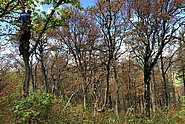The analysis of stable carbon and oxygen isotopes in tree-rings is a widely applied tool which allows to retrieve information about past climatic conditions, as well as tree physiological responses to environmental changes. This is based on well-established mechanistic models and firm statistical relationships with climate variables. In contrast, the hydrogen isotopic signature (δ2H) of tree-rings has been reported to be poorly correlated to climate or difficult to explain, and as a consequence, hydrogen isotopes are far less utilized. However, recent plant-physiological experiments have highlighted the role of autotrophic versus heterotrophic processes affecting δ2H values, i.e. use of fresh assimilates versus stored carbohydrates, and have much improved our understanding of the role of post-photosynthetic 2H-fractionation. Using unpublished and literature δ2H data of tree-ring cellulose (δ2HC) of 5 study sites in Europe and Asia, we systematically investigated the relationships between δ2HC and tree-ring width (TRW), which, in contrast to previous research, could now be explained through post-photosynthetic 2H-fractionation. In most cases, these relationships were found to be negative (r2 = 0.23 to 0.51, all P < 0.05) when the main growth limiting factors are precipitation and light, while in temperature-limited sites we observed a positive trend (r2 = 0.14, P < 0.05). Our results suggest that, under stress conditions, trees use a surplus of carbon from reserves for wood formation. Therefore, in combination with TRW chronologies, δ2HC may allow to infer about physiological information on stressful time periods independently of biotic and abiotic origin. Here, we discuss implications of these findings for tree-ring research, summarize them in a conceptual framework and suggest future research directions.
Siehe DOISiehe Institutional Repository DORA


